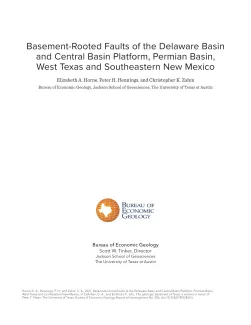
Publication Details
Get the Publication
$8.00
Abstract/Description:
The Permian Basin of Texas and New Mexico is an important petroleum province with a complex tectonic history. This region has been shaped by several divergent and convergent deformation events since the Proterozoic Eon. Each subsequent event was influenced by the accumulated tectonic fabric through fault reactivation and strain transfer. These events have generated a complex network of regional faults that have spatially compartmentalized the Permian Basin.
This work provides a new interpretation of basement-rooted faults in the Delaware Basin and surrounding structural flanks. This interpretation can be used to understand controls on issues involving faulting, including but not limited to neotectonic stress state, basin tectonostratigraphic evolution, reservoir productivity and production characteristics, and both natural and induced seismicity.
A three-dimensional structural framework is used to develop a regional-scale fault map, a three-dimensional structural analysis, and an interpretation of the controlling fabrics and their kinematic evolution. The interpretation contains >650 basement-rooted fault surfaces.
This region is dominated by north-northwest–south-southeast-striking high-angle reverse faults, which make up 48 percent of the total faults. Blocks bounded by these north-northwest–south-southeast-striking primary faults are compartmentalized by two secondary fault orientations observed regionally (west-northwest–east-southeast and west-southwest–east-northeast), the most notable of which is the east-northeast-striking Grisham fault zone.
Features within this secondary structural grain include a network of linked contractional faults, which accommodate significant reverse dip-slip and minor strike-slip movement, contractional fault-propagation folds, and smaller-scale, similarly trending oblique-slip fault zones. This fabric formed in response to contractional and localized strike-slip strain, and many of these features may have potentially been reactivated.
In some locations, this secondary fabric is accompanied by a third-order north-northeast–south-southwest fault set, which formed in association with accumulated contractional and localized strike-slip strain.
Faults were classified according to morphology (orientation, length, offset) and mapping confidence (high and moderate). These fault attributes were assessed statistically, which included the generation of length frequency plots between fault groups and measurement of fault offsets (throw-length ratio and apparent-throw summation across the data region). These statistical analyses were compared to qualitative observations of variations in fault throw across the mapped region and provided grounds to develop a qualitative kinematic interpretation.
A new kinematic model suggests that the primary structural grain (north-northwest–south-southeast striking, group 1) formed first, in response to the encroaching Ancestral Rocky Mountain orogenic front. Secondary fault zones (west-northwest–east-southeast and east-northeast–west-southwest striking, group 2) formed under the combined stresses from the Ancestral Rocky Mountain and Marathon–Ouachita convergence fronts, compartmentalizing the Delaware Basin and Central Basin Platform.
Subordinate structures (north-northeast–south-southwest striking, group 3) are attributed to local realignment of stresses from interacting primary and secondary fault systems, or potentially from the reactivation of preexisting first- and second-order faults during later Laramide convergence.